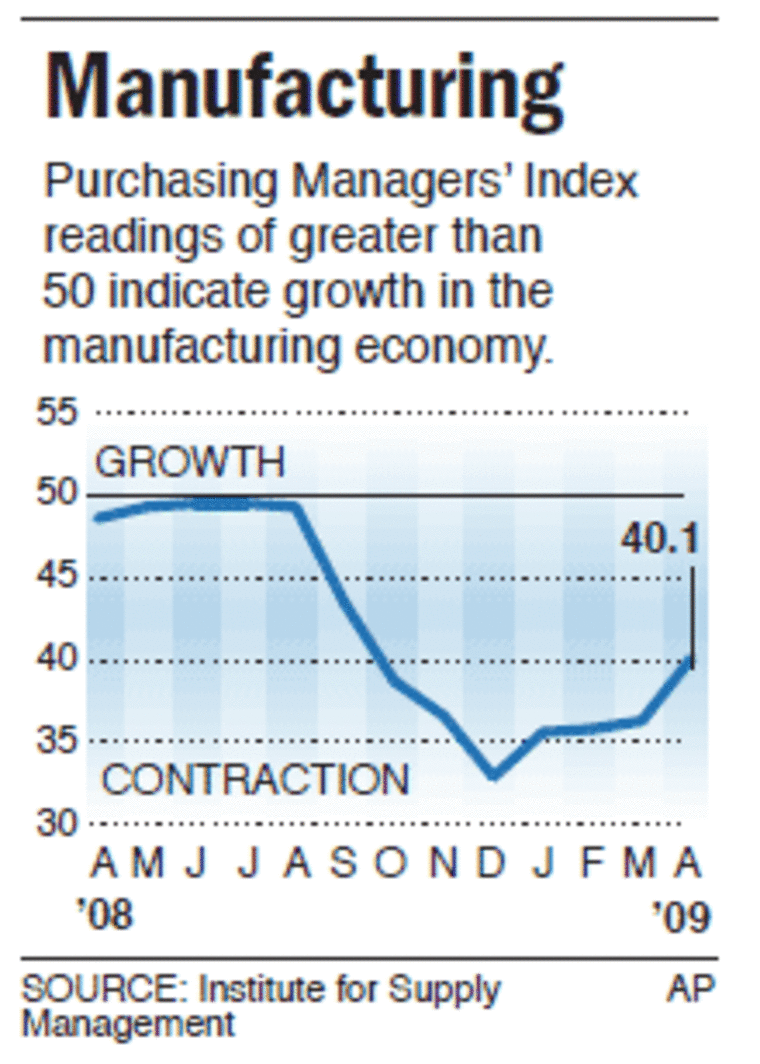U.S. manufacturing activity in April posted its best showing since September, when the financial crisis erupted. The performance was driven by a rise in new orders reflecting higher business and consumer spending.
The strength in forward-pointing new orders was especially encouraging. It indicated that after slashing inventories in the first quarter, manufacturers see the need to place new orders for other businesses and consumers.
More orders signal that higher consumer spending — which accounts for about 70 percent of economic activity — is causing businesses to boost demand. Such spending is crucial to an economic recovery.
The Institute for Supply Management, a trade group of purchasing executives, said its manufacturing index rose to 40.1 in April from 36.3 in March. While anything below 50 indicates manufacturing is contracting, 40.1 was the highest level since September. In March, the index was 36.3.
Experts cautioned that manufacturers, particularly in the auto industry, still face serious troubles. And the overall economy, as measured by the gross domestic product, contracted at a 6.1 percent rate in the first three months of this year after a 6.3 percent fall in the fourth quarter, the worst back-to-back readings in a half century.
They said the most positive view of the April report is that the deep slide in manufacturing that occurred last fall could be nearing an end.
“This is another sign that the depth and speed of the economic decline seems to be leveling off,” said Stuart Hoffman, chief economist at PNC Financial in Pittsburgh.
As new orders rose sharply in April, company inventories shrank for a 36th straight month. That suggested factories may need to ramp up their output even more — activity that will eventually help stimulate the economy.
For the first time since July, manufacturers’ customers did not think their own inventories were too high, the survey found. This means new orders should rise further in coming months as wholesalers and retailers restock. The ISM’s new-orders index reached 47.2, up 6 percentage points from March.
Nigel Gault, chief U.S. economist for IHS Global Insight, said the ISM reading suggested that the rate of GDP decline could slow significantly in the current April-June period, to perhaps a drop of around 2 percent to 3 percent. The decline in GDP could be even smaller in the third quarter, before a recovery begins in the final three months of this year, he said.
The ISM index, based on a survey of members of the Tempe, Ariz.-based group, had fallen steadily as the economy deteriorated late last year, hitting a 28-year low in December. The index covers indicators such as new orders, production, employment, inventories, prices, and export and import orders.
In a separate report, though, the Commerce Department said factory orders fell 0.9 percent in March, worse than the 0.6 percent drop economists had expected.

For March, orders for durable goods dropped 0.8 percent as strength in demand for commercial jetliners and military aircraft offset weakness in other areas. Orders for nondurable goods, products such as petroleum, chemicals and paper, dropped 1 percent after a 0.2 percent fall in February.
Ford Motor Co., meanwhile, grabbed a bigger slice of the U.S. car market in April, even as its overall sales dropped 32 percent. Ford said sales of light trucks and vehicles fell 32 percent compared with sales in April 2008.
On Wall Street, stocks posted modest gains, with the Dow Jones industrial average rising more than 44 points, or 0.54 percent.
The ISM report for April showed that manufacturing inventories contracted for the 36th straight month, though at a slower pace than before. Smaller inventories are an important signpost because they indicate that companies will eventually need to restock goods and boost production to meet new orders. That would help revive the economy.
Auto factories have been particularly hammered in recent months. Chrysler LLC filed for bankruptcy protection Thursday, announcing that it would temporarily halt most of its vehicle production while completing a deal with Italian carmaker Fiat.
Other manufacturing companies also are enduring rough times.
Dow Chemical, based in Midland, Mich., this week reported a 97 percent drop in its first-quarter profit as its big commercial customers cut back on purchases, though the results beat Wall Street’s expectations. Because Dow’s chemicals are used in everything from toys to automobiles, the global economic downturn has hit the company especially hard.
Consumer goods manufacturer Colgate-Palmolive Co. said this week that higher prices and cost-cutting helped its first-quarter profit jump 9 percent despite being buffeted by a stronger dollar and a drop in European sales.